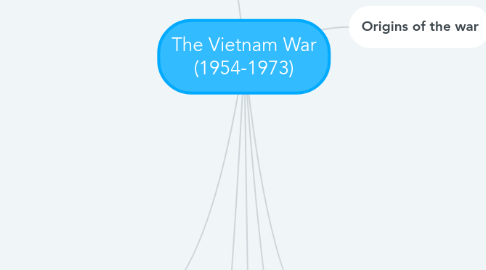
1. What was the Vietnam War?
1.1. The Vietnam War was a long and divisive conflict that put the communist government of North Vietnam against South Vietnam and its principal ally, the United States. The conflict was intensified by the ongoing Cold War between the United States and the Soviet Union. More than 3 million people (including over 58,000 Americans) were killed in the Vietnam War, and more than half of the dead were Vietnamese civilians.
2. America's involvement
2.1. Under President Einsenhower
2.1.1. Einsenhower saw Vietnam as a crucial part of his Domino theory and was therefore constantly trying to avoid the possibility of Vietnam becomming communist. In 1953 he intervened in the war between France and Vietnam to support the French with military equipment and when the French war effort failed he turned his attention to supporting the South.
2.2. Under President Kennedy
2.2.1. Kennedy wanted to appear strong after the failed Bay of Pigs Invasion at the Cuban Missiles Crisis. In 1961 he arranged to give the South Vietnamese the money necessary to increase the size of its army. In 1962 the Strategic Hamlet Program was introduced, where peasants were moved to new villages to avoid them being influenced by the Vietcong. This operation failed because they refused.
2.3. Under President Johnson
2.3.1. He aimed for a full-scale war break out. In 1964 a confrontation known as "The Gulf of Tonkin Incident" resulted in the start of real warfare between America and North Vietnam. Under Johnson American commitment to the Vietnam War was at its strongests. The number of men conscripted was increased through "the draft", a system where young men physically capable of fighting were called to the army as needed.
3. How was the war fought?
3.1. The Vietnam War was a Guerrilla Warfare, a type of combat that's fought by a civilian population or other people who aren't part of a typical military unit using military tactics including ambushes, sabotage, raids, petty warfare, hit-and-run tactics, and mobility, to fight a larger and less-mobile traditional military.
3.1.1. As the United States became increasingly mired in Vietnam, it pursued a strategy of Attrition, attempting to bury the Vietnamese Communist forces under an avalanche of casualties. However, the Viet Cong’s Guerrilla Tactics frustrated and demoralized U.S. troops, while its dispersed, largely rural presence left American bomber planes with few targets. The United States therefore used unconventional weapons such as Napalm and the herbicide defoliant Agent Orange but still managed to make little headway.
4. China and USSR involvement
4.1. The USSR was a major supplier of military aid such as arms, missiles and petrol. China was the supply route through which they were delivered to North Vietnam. At first the Soviets tried to urge peace while China encouraged the North to fight the ‘War of Liberation’. As the United States poured men and money into South Vietnam, Chinese and Soviet involvement in Vietnam also increased. As the world’s largest communist powers, both the Soviet Union and China gave moral, logistic and military support to North Vietnam. They hoped to build and expand communism in the Asia. Neither the USSR nor China was open about the nature of the support they provided to North Vietnam and the National Liberation Front (NLF) which included its military wing, the Vietcong. Soviet and Chinese support was vital to North Vietnam and contributed to the successes of its operations in South Vietnam.
5. Origins of the war
5.1. The Vietnam War started in the 1950s, according to most historians, though the conflict in Southeast Asia had its roots in the French colonial period of the 1800s. The Vietnamese fought for independence and won in 1954. The country was split into communist North Vietnam and non-communist South Vietnam, and the conflict started after the differences between the two sides did not let them convive (This is better explained in the question of how did the war start in exercise 2)
6. The end of the war
6.1. In January 1973, the United States and North Vietnam concluded a final peace agreement, ending open hostilities between the two nations. War between North and South Vietnam continued, until 1975. After years of warfare, an estimated 2 million Vietnamese were killed, while 3 million were wounded and another 12 million became refugees. Warfare had demolished the country’s infrastructure and economy, and reconstruction proceeded slowly. In 1976, Vietnam was unified as the Socialist Republic of Vietnam, though sporadic violence continued over the next 15 years, including conflicts with neighboring China and Cambodia.
7. The Antiwar Movement
7.1. The Antiwar Movement within the United States gained momentum as many Americans denounced the war. Protests against the war and the military Draft grew increasingly violent, resulting in police brutality outside the Democratic National Convention in 1968 and the deaths of four students at Kent State University in 1970 when Ohio National Guardsmen fired on a crowd. Despite the protests, Johnson’s successor, President Richard M. Nixon, declared that a “Silent Majority” of Americans still supported the war.
7.1.1. Nonetheless, Nixon promoted a policy of Vietnamization of the war, promising to withdraw U.S. troops gradually and hand over management of the war effort to the South Vietnamese. Although Nixon made good on his promise, he also illegally expanded the geographic scope of the war by authorizing the bombing of Viet Cong sites in the neutral nations of Cambodia and Laos, all without the knowledge or consent of the U.S. Congress.

